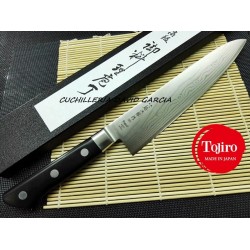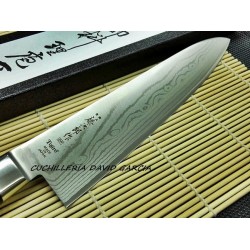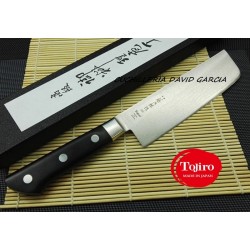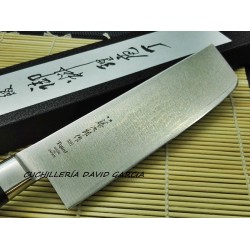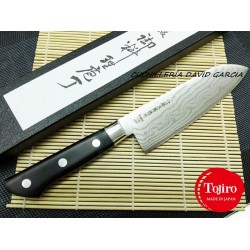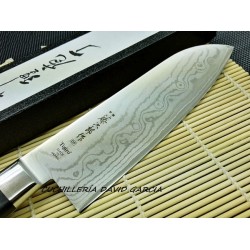TOJIRO JAPÓN - Orgullo y Tradición
Cuchillo de cocina se llama “Hou-cho” en japonés. La palabra originaria de China y significa “una espada de Houtei”. “Houtei” es el nombre del legendario cocinero chino existió hace más de 2000 años de acuerdo con el chino viejo libro taoísta “Zhuangzi”.
Hay una leyenda que “Houtei” maneja el cuchillo con habilidad y mató a miles de reses sin romper o picar la hoja, e incluso sin afilar durante décadas.
Con respecto a “Houtei”, su nombre había pasado de alguna manera durante miles de años y lejos de China a Japón. Pero lo interesante es, la palabra “Houtei” o “Hou-cho” no se utiliza en el presente China, que están ahora solamente se emplean en idioma japonés.
Desde la Edad de Piedra, ya sea piedra, acero o cerámica, cuchillos han sido herramientas indispensables para los seres humanos.
Los cuchillos de cocina más antiguos encontrados en Japón es del periodo Nara (718-784 dC), que ahora se guarda y se mantiene en “Shosoin”, la casa del tesoro pertenece al templo Todaiji en Nara Prefecture.
Se ven como espadas japonesas primitivas. Ese tipo de cuchillos se utilizó hasta principios del siglo 17, y luego se mejoró a tipo moderno después de eso. Cuchillos japoneses como “Deva” “Yanagiba” y “Nakiri” son las creaciones de esta época moderna.
En la mitad del siglo 17, tan pronto como gobierno japonés levantó la política de relaciones exteriores de bloqueo del país, diversos bienes y la cultura empezaron a llegar a Japón. Los cuchillos de cocinero occidentales fueron llevados en este período y se extendió rápidamente y aceptados por los japoneses.
En los tiempos modernos, en torno a mediados de 1900, el japonés tomó ventajas de Occidental cuchillo cocinero y cuchillo tradicional japonesa, y el cuchillo innovado “Santoku”. Santoku es ahora reconocido en todo el mundo.
Hoy cuchillos de cocina japoneses son conocidos como de alta calidad, y también hábil técnica detrás de eso es bien reconocida. Como cuestión de hecho, algunos fabricantes de cuchillos japoneses están produciendo los modelos más emblemáticos de los otros bien conocidos fabricantes de cuchillos en el extranjero.
Actualmente Fujitora Industria está poniendo mucho esfuerzo en la exportación, y nuestra calidad, nitidez y sofisticado diseño son altamente reconocidos por muchos usuarios en todo el mundo.
Lo que hemos estado persiguiendo desde nuestra fundación es la “nitidez”.
Creemos que la tecnología avanzada no es el único factor para producir excelentes productos. Estimando a la técnica tradicional, esfuerzo incesante de los estándares más altos, varias consultas con proveedores de materiales, millones de pruebas y fracasos - todos estos son los factores de nuestro espíritu de fabricación.
Nuestro método original patentado DP (Prevención Descarburación), Good Design Award reconoce a muchos de nuestros productos por el Ministerio de Comercio Internacional e Industria de Japón, por ejemplo, son los resultados de nuestro entusiasmo.
Ahora tenemos más de 800 artículos, y nuestra cantidad de ventas es el nivel superior entre los fabricantes de cuchillos en la prefectura de Niigata, y también entre los 5 primeros en el país.
Es un placer para introducir nuestros productos al mercado en todo el mundo. Por favor, echar un vistazo, y disfrutar del mundo de Tojiro Japón.
Cuchillo de cocina se llama “Hou-cho” en japonés. La palabra originaria de China y significa “una espada de Houtei”. “Houtei” es el nombre del legendario cocinero chino existió hace más de 2000 años de acuerdo con el chino viejo libro taoísta “Zhuangzi”.
Hay una leyenda que “Houtei” maneja el cuchillo con habilidad y mató a miles de reses sin romper o picar la hoja, e incluso sin afilar durante décadas.
Con respecto a “Houtei”, su nombre había pasado de alguna manera durante miles de años y lejos de China a Japón. Pero lo interesante es, la palabra “Houtei” o “Hou-cho” no se utiliza en el presente China, que están ahora solamente se emplean en idioma japonés.
Desde la Edad de Piedra, ya sea piedra, acero o cerámica, cuchillos han sido herramientas indispensables para los seres humanos.
Los cuchillos de cocina más antiguos encontrados en Japón es del periodo Nara (718-784 dC), que ahora se guarda y se mantiene en “Shosoin”, la casa del tesoro pertenece al templo Todaiji en Nara Prefecture.
Se ven como espadas japonesas primitivas. Ese tipo de cuchillos se utilizó hasta principios del siglo 17, y luego se mejoró a tipo moderno después de eso. Cuchillos japoneses como “Deva” “Yanagiba” y “Nakiri” son las creaciones de esta época moderna.
En la mitad del siglo 17, tan pronto como gobierno japonés levantó la política de relaciones exteriores de bloqueo del país, diversos bienes y la cultura empezaron a llegar a Japón. Los cuchillos de cocinero occidentales fueron llevados en este período y se extendió rápidamente y aceptados por los japoneses.
En los tiempos modernos, en torno a mediados de 1900, el japonés tomó ventajas de Occidental cuchillo cocinero y cuchillo tradicional japonesa, y el cuchillo innovado “Santoku”. Santoku es ahora reconocido en todo el mundo.
Hoy cuchillos de cocina japoneses son conocidos como de alta calidad, y también hábil técnica detrás de eso es bien reconocida. Como cuestión de hecho, algunos fabricantes de cuchillos japoneses están produciendo los modelos más emblemáticos de los otros bien conocidos fabricantes de cuchillos en el extranjero.
Actualmente Fujitora Industria está poniendo mucho esfuerzo en la exportación, y nuestra calidad, nitidez y sofisticado diseño son altamente reconocidos por muchos usuarios en todo el mundo.
Lo que hemos estado persiguiendo desde nuestra fundación es la “nitidez”.
Creemos que la tecnología avanzada no es el único factor para producir excelentes productos. Estimando a la técnica tradicional, esfuerzo incesante de los estándares más altos, varias consultas con proveedores de materiales, millones de pruebas y fracasos - todos estos son los factores de nuestro espíritu de fabricación.
Nuestro método original patentado DP (Prevención Descarburación), Good Design Award reconoce a muchos de nuestros productos por el Ministerio de Comercio Internacional e Industria de Japón, por ejemplo, son los resultados de nuestro entusiasmo.
Ahora tenemos más de 800 artículos, y nuestra cantidad de ventas es el nivel superior entre los fabricantes de cuchillos en la prefectura de Niigata, y también entre los 5 primeros en el país.
Es un placer para introducir nuestros productos al mercado en todo el mundo. Por favor, echar un vistazo, y disfrutar del mundo de Tojiro Japón.
Marca: TOJIRO
Modelo: TF-655
Cuchillo Tojiro DP Damasco 37 capas Cocinero 21 cm
Estilo japonés, cuchillo de cocina de acero damasco 37 capas.
Tojiro ha fabricado una gran cantidad de cuchillos de cocina con hojas hechas a partir de los conocimientos técnicos de procesamiento de materiales de varias capas. Originalmente se us..
247.00€
Impuestos:204.13€
Marca: TOJIRO
Modelo: TF-660
Cuchillo Tojiro DP Damasco 37 capas Nakiri 16,5 cm
Estilo japonés, cuchillo de cocina de acero damasco 37 capas.
Tojiro ha fabricado una gran cantidad de cuchillos de cocina con hojas hechas a partir de los conocimientos técnicos de procesamiento de materiales de varias capas. Originalmente se usa..
320.25€
Impuestos:264.67€
Marca: TOJIRO
Modelo: TF-659
Cuchillo Tojiro DP Damasco 37 capas Santoku 17 cm
Estilo japonés, cuchillo de cocina de acero damasco 37 capas.
Tojiro ha fabricado una gran cantidad de cuchillos de cocina con hojas hechas a partir de los conocimientos técnicos de procesamiento de materiales de varias capas. Originalmente se usab..
230.00€
Impuestos:190.08€
Mostrando 1 a 3 de 3 (1 Páginas)

